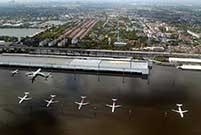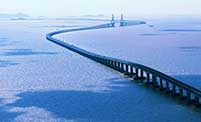

New technology
The new carrier has been designed in China and will have a displacement of 50,000 metric tons, a conventional power system, and will carry domestically developed J-15 fighter jets and other ship-borne aircraft, Yang said.
The ship will use a ski jump mode for launching fixed-wing aircraft, the same as the Liaoning, he added.
Zhang said the new carrier's three major systems-power and propulsion, electronic systems and weapons-will all be developed by China and will have better capabilities than those on the Liaoning.
He said China will consider developing a nuclear-powered aircraft carrier after it gains enough experience in operating such large vessels.
Chen Xuesong, a fellow researcher at the PLA Naval Military Studies Research Institute, said he believes the new carrier, which is being constructed in sections to be assembled later, will be a tough challenge for Chinese engineers.
Quality guarantee
"Although we have gained expertise and know-how from the Liaoning refit project, the new vessel will truly be the first time for us to design and build an aircraft carrier," he told China Daily. "Our engineers must make sure their structural design is good and guarantee the quality of the steel parts."
Beyond the second carrier, China is looking into a host of cutting-edge technologies that can be used on future vessels.
China Shipbuilding Industry Corp, which refitted the Liaoning and is building the second carrier, has been researching nuclear-powered ships since 2013.
Du Wenlong, a senior researcher at the PLA Academy of Military Science, previously has said that it is highly possible that the navy's next-generation aircraft carrier will be equipped with nuclear propulsion.
China already has nuclear submarines that require highly sophisticated technologies and manufacturing capabilities, so developing a nuclear carrier will not be difficult, he said.
 |
 Are these the world’s scariest landing strips?
Are these the world’s scariest landing strips? In pics: Left behind children in China
In pics: Left behind children in China Eight modern day engineering marvels of China
Eight modern day engineering marvels of China Chinese beauty with sexiest bottom
Chinese beauty with sexiest bottom Charming female bodybuilders of Chengdu University
Charming female bodybuilders of Chengdu University Polish sports stars strip off for risqué calendar
Polish sports stars strip off for risqué calendar Spectacular aerial photos of the Three Gorges
Spectacular aerial photos of the Three Gorges Contestants of Mrs. Globe pose for photo in Shenzhen
Contestants of Mrs. Globe pose for photo in Shenzhen
 Bikini models attend hot pot banquet in Hefei
Bikini models attend hot pot banquet in Hefei Top 20 hottest women in the world in 2014
Top 20 hottest women in the world in 2014 Top 10 hardest languages to learn
Top 10 hardest languages to learn 10 Chinese female stars with most beautiful faces
10 Chinese female stars with most beautiful faces China’s Top 10 Unique Bridges, Highways and Roads
China’s Top 10 Unique Bridges, Highways and Roads Face of China 2015
Face of China 2015 A hard year 2015’s stories
A hard year 2015’s stories Smartphone makers jockey for dominance of Chinese market
Smartphone makers jockey for dominance of Chinese market Film star's posts stirs debates on Chinese, foreign medical services
Film star's posts stirs debates on Chinese, foreign medical servicesDay|Week